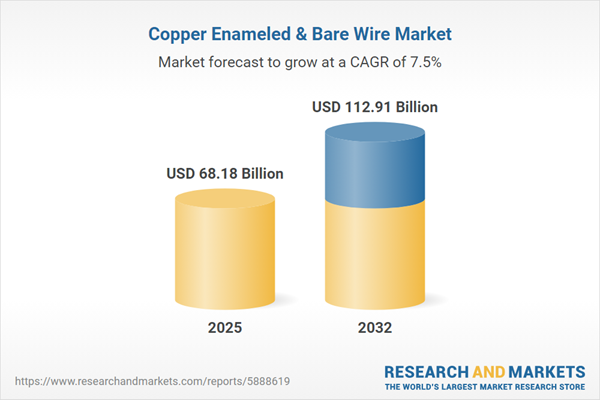Speak directly to the analyst to clarify any post sales queries you may have.
The copper enameled and bare wire market is undergoing dynamic transformation as electrification initiatives and modern industrial systems gain momentum worldwide. Senior leaders are prioritizing reliable sourcing and future-ready technology strategies to secure operational resilience.
Market Snapshot: Copper Enameled & Bare Wire Market
In 2024, the global copper enameled and bare wire market is valued at USD 63.43 billion, with an expected rise to USD 68.18 billion by 2025 and projected expansion to USD 112.91 billion by 2032. Growth is fueled by intensified global investments in electrification and significant advancements in electrical infrastructure, which are driving demand across electric vehicle manufacturing, renewable energy projects, and high-performance industrial settings. Both suppliers and OEMs are enhancing product durability, integrating advanced insulation technologies, and implementing contemporary designs to meet evolving operational and regulatory standards. These shifts underscore the importance of robust and reliable copper wiring for companies looking to modernize and adapt to a rapidly changing technological landscape.
Scope & Segmentation: Copper Enameled & Bare Wire Market
- Product Types: Solid bare wire and stranded copper serve as essential materials for electrification, while enameled wire, coated with polyester or polyurethane, ensures extended insulation and service life. These wire types meet the requirements of electronic assemblies, electrical motors, and installations demanding longevity and thermal stability.
- Application Areas: Copper wiring is integrated across automotive electronics, electric motor production, power generation systems, telecommunications infrastructure, electronics assembly processes, and transformer output circuits, ensuring steady performance in sectors such as energy, mobility, and advanced manufacturing.
- Conductor Types: Options include rectangular, round, and square copper conductors, supporting engineering teams with the flexibility to meet a range of technical specifications and to align with international compliance mandates. This variety increases compatibility across diverse manufacturing lines and infrastructure updates.
- Insulation Classes: Classes spanning from A to H empower organizations to meet evolving thermal management and safety requirements. Compliance with current regulatory codes is streamlined for OEMs and industrial users through these tailored insulation options.
- Distribution Channels: Sourcing can occur through direct procurement, regional distributors, digital supply platforms, or OEM-focused distribution, enabling businesses to enhance supply control, respond swiftly to market variability, and utilize both localized and worldwide logistics networks.
- Regional Markets: The Americas, Europe, Middle East, Africa, and Asia-Pacific serve as primary regional markets, with strong activity from the United States, Germany, India, China, Brazil, and the UAE. These geographies differ in infrastructure investment strategies and regulatory environments, encouraging companies to customize their distribution and sourcing approaches for optimal growth and compliance.
Key Takeaways for Senior Decision-Makers
- Copper wiring offers vital adaptability, enabling businesses to seamlessly adjust to shifts in technology, regulatory requirements, and sector-specific operational needs.
- Bare copper wire is favored for use in high-voltage and mechanically demanding environments, whereas enameled wire suits applications requiring compact design and advanced insulation, particularly in electronics and precision manufacturing.
- Recent innovations in copper alloy compositions and insulation materials are improving longevity and keeping pace with evolving energy efficiency and regulatory standards.
- Precision manufacturing and digitalized production techniques support ongoing improvements in quality assurance and operational efficiency, catering to strict customer requirements.
- Adopting sustainable practices such as copper recycling and responsible material sourcing underpins stability across the supply chain and aligns with corporate sustainability initiatives.
- Regional diversification of suppliers provides a buffer against global trade volatility, helping businesses sustain production and adapt rapidly to market disruptions.
Tariff Impact: Procurement and Supply Chain Strategies
Impending U.S. tariff changes in 2025 are prompting procurement leaders to restructure supplier relationships. Focusing on domestic production and expanding partnerships reduces exposure to policy shifts. These strategies enable organizations to maintain supply continuity and support agile responses to fluctuating trade conditions within the copper enameled and bare wire market.
Methodology & Data Sources
This report synthesizes insights from senior industry interviews, in-depth sector surveys, regulatory reviews, and independent third-party technology research. The comprehensive approach delivers reliable intelligence senior leaders can trust for making strategic procurement and supply decisions within the copper wire sector.
Why This Report Matters
- Enables senior executives to refine procurement strategies, ensure compliance, and proactively manage operational risk in a changing market environment.
- Supports resilience initiatives throughout the supply chain and helps organizations integrate sustainability into sourcing frameworks for sustained competitiveness.
- Provides actionable intelligence for optimizing technology investments, improving supply processes, and driving operational improvement across industrial portfolios.
Conclusion
By applying these research-driven insights, decision-makers can optimize supply strategies, uphold regulatory compliance, and retain agility as copper wire advances and market conditions evolve.
Additional Product Information:
- Purchase of this report includes 1 year online access with quarterly updates.
- This report can be updated on request. Please contact our Customer Experience team using the Ask a Question widget on our website.
Table of Contents
3. Executive Summary
4. Market Overview
7. Cumulative Impact of Artificial Intelligence 2025
Companies Mentioned
The companies profiled in this Copper Enameled & Bare Wire market report include:- Prysmian S.p.A.
- Nexans S.A.
- Southwire Company, LLC
- Sumitomo Electric Industries, Ltd.
- LS Cable & System Ltd
- Furukawa Electric Co., Ltd.
- Encore Wire Corporation
- Belden Inc.
- Superior Essex International LP
- Jiangsu Zhongtian Technology Co., Ltd.
Table Information
| Report Attribute | Details |
|---|---|
| No. of Pages | 186 |
| Published | October 2025 |
| Forecast Period | 2025 - 2032 |
| Estimated Market Value ( USD | $ 68.18 Billion |
| Forecasted Market Value ( USD | $ 112.91 Billion |
| Compound Annual Growth Rate | 7.4% |
| Regions Covered | Global |
| No. of Companies Mentioned | 11 |









